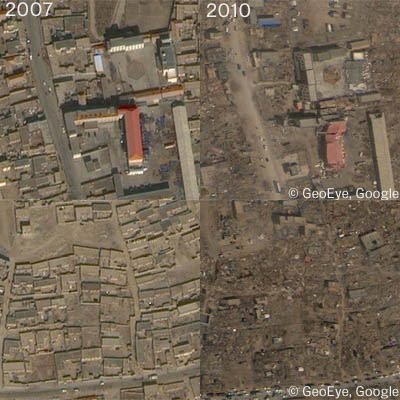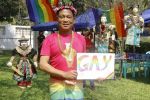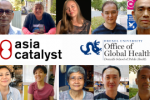
by Robbie Barnett
News Update on Jyeku/Yushu Earthquake Relief activities, 20th April 2010
DEATH TOLL CONTINUES TO RISE: Officials reported on 20th April that the death toll had risen to 2,064, with more than 12,000 injured and 175 still missing.
SNOW IN JYEKU: Snow and hail fell in Jyeku today, further hampering recovery efforts.
MASS PRAYERS: A mass prayer ceremony for the victims was held by monks and others held in Jyeku on 20th April, following the cremation of around 1000 bodies by the Jyeku monks on Saturday 17th April.
There are still reports of occasional looting but several journalists also noted how Tibetans formed queues to wait for food distribution. Several aid trucks overturned on the road from Xining to Jyeku
DALAI LAMA’S REQUEST TO VISIT JYEKU ACKNOWLEDGED by China without negative comment: Xinhua noted the Dalai Lama’s request to visit without any negative comment on it, and repeated the Foreign Ministry spokeswoman Jiang Yu’s statement, perhaps the first time since 1993 that the Chinese press has referred to the Dalai Lama with attacking him:
“Most of the Yushu population are ethnic Tibetans and the Dalai Lama had expressed his wish to visit the quake-hit area to comfort victims. In response to a question concerning the Dalai Lama at the press conference, Jiang said the government fully respected local religious beliefs and customs, and was offering counseling.” (“Foreign countries offer quake relief funds to China”, Xinhua 2010-04-20 https://news.xinhuanet.com/english2010/china/2010-04/20/c_13259997.htm)
VIDEO OF PRAYERS: Moving video of a Tibetan woman praying for her mother at the mass cremation can be seen at https://news.sohu.com/20100418/n271584849.shtml. The film is by a Chinese person who does not understand Tibetan. The woman is praying to the Dalai Lama.
POWERFUL PHOTOGRAPHS at the Boston Globe’s site at https://www.boston.com/bigpicture/2010/04/earthquake_in_yushu_china.html no. 7
APPEAL FOR HELP from the Tibet Girls School in Jyeku, founded by a Chicago-based Tibetan exile who has lost 30 people from his family. See https://www.evanstonmeditation.org/tibet_girls_press.html
+++++
PRC OFFICIAL STATEMENTS
China “welcomes international aid” to quake relief
China’s Foreign Ministry spokeswoman said “some countries and organizations have expressed their willingness to offer assistance, which is a clear manifestation of their goodwill to China and [the] “Chinese government welcomes and sincerely appreciates their goodwill,” she said, adding that the information for receiving donations has been published. “We welcome and sincerely appreciate the international community’s concern and support,” ministry spokeswoman Jiang Yu told a regular press conference (https://news.xinhuanet.com/english2010/china/2010-04/19/c_13257306.htm).
PRC welcomes exiles to return for funerals or send donations, offers to help
Jia Qinglin, in charge of China’s religious and nationality affairs and of the United Front, “called on ethnic and religious departments to go deep into the disaster-hit areas to assess conditions and cooperate with other groups in helping monks protect themselves from aftershocks while holding rituals for the dead. Jia said Chinese embassies abroad should warmly receive all overseas Tibetans who requested to donate to the quake-hit areas or come back to China for funeral affairs, and offer them necessary assistance. (“Top political advisor stresses unity in quake relief” Xinhua, April 20, 2010 (https://news.xinhuanet.com/english2010/china/2010-04/19/c_13258550.htm) https://paper.people.com.cn/rmrb/html/2010-04/20/nw.D110000renmrb_20100420_6-01.htm) [NOTE: The full Chinese-language text is much less conciliatory – details to follow in next update]
Praise for Tibetans in Chinese press:
A Tibetan from Kham (whose name is indecipherable from the Chinese, which has “Bairi Daile”) is praised for establishing an orphanage in Kham that did not collapse (implying that the building process was carefully supervised). “Yushu orphanage stands and did not fall after the earthquake: 105 children were not injured” China Youth Daily 20 April 2010.
. https://news.sina.com.cn/c/2010-04-20/043320109122.shtml
Plans for future: ecotourism
“Post-quake reconstruction has been also on the agenda. Reporter learned yesterday from the Government of Qinghai Province, the overall objective of the principle of reconstruction will be: building a high-altitude eco-tourism city.” (“Yushu in Qinghai Province plans to rebuild the city into a plateau of eco-tourism” Xinhua, 20 April 2010 https://news.sina.com.cn/c/2010-04-19/024320100663.shtml)
PRC announces national mourning
PRC Government declares a nation-wide period of mourning with flags at half mast on Wednesday afternoon, April 21st “to express in various ways condolences to quake victims in Yushu in Qinghai” and to stop public entertainment. (https://www.guardian.co.uk/world/2010/apr/20/china-quake-mourning-shutdown )
Quake victims moved to hospitals
By 20th April, 322 injured people had been received in hospitals in Chengdu, Ya’an, Dartsedo (Ch. Kangding) and elsewhere in Sichuan. (https://news.sina.com.cn/c/2010-04-20/191317399970s.shtml)
PRC government says there must be public accounts for all donations.
“An accounting system must be set up to keep track of donations, and expenditure must be made public. It also asked the local authorities to strengthen supervision of the donations and vowed harsh punishments for offenses like embezzlement.”
Rescues
2 people rescued after 123 hours (https://news.sina.com.cn/c/2010-04-20/041520109041.shtml)
Some PRC articles about the vice-premier Hui Liangyu’s brief praise of monks
Vice-premier Hui noted that “the monks are patriotic, loving Buddhist teaching, love their hometown, this town is a multi-ethnic and multi-religious area, the religious people also must play important roles in earthquake relief work”. These remarks are covered in the Chinese press (A paragraph summarizing Hui’s comments on religion (Minzu Bao (Nationality News) https://www.mzb.com.cn/zgmzb/html/2010-04/20/content_67443.htm; Xinhua’s report on Hui ‘s visit and his praise of the monks and religious masses (https://news.xinhuanet.com/politics/2010-04/15/c_13252548.htm; Hui Liangyu’s comments are also highlighted here and widely cited by many websites (https://news.china.com.cn/rollnews/2010-04/16/content_1631931.htm). But there are few references to monk rescuers.
Monk rescue work not shown on Chinese TV
Very little if anything showing the monks carrying out rescue work has been shown on Chinese television. The cremation and prayers by the monks were also not shown on Chinese television. Anything said by Premier Wen Jiaobao to the monks when he visited Jyeku Dondrupling monastery has not been reported in the Chinese press, notes Reuters: “Premier Wen Jiabao visited a monastery on Friday and thanked monks for their work, foreign journalists in Yushu said, although state media did not report the visit” apart from photographs (“China’s Hu flies in,” Reuters, April 18).
There are very few press reports in China about or photos of the monks’ rescue work – the notable exceptions include https://www.qingdaonews.com/gb/content/2010-04/18/content_8351744.htm and https://epaper.bjnews.com.cn/html/2010-04/18/node_18.htm. – but nothing on television.
+++++
NGO NEWS
YER Consortium
YER, the consortium of local NGOs in Xining, has set up a website at https://www.yushuearthquakeresponse.org/ with updates on their work. Besides food and tool,s they have sent to Jyeku include 4 motorbikes so that the community workers can get out to villages to check conditions and needs there. The bikes cost 12,000 rmb, about $1750. They describe their work:
April 20
As each day goes by, we begin to feel as if the situation is slowly getting under control. Last night the team in Yushu completed another successful distribution, as well as two more today.
Here is a description of one of today’s distributions:
– Morning assessment first conducted by Mr. Tashi at Dang Dai Road (500m from Jiegu’s first bridge).
– A family name list is prepared during the assessment so that the distribution can be controlled and counted. A team of 13 volunteers under the supervision of the SSG program director was deployed with the supply truck. Security was facilitated by 6 monks from the Jiegu Monastery.
– Families are called one by one, with each family receiving:
* One bag of potatoes or radishes (40kg)
* One pack instant noodles
* Half dozen bottles mineral water
* One pack of noodles
* One bag of rice (10kg)
* Leeks (one bunch)
– Supplies were delivered to 179 households, and basic medical care was given to each family by a volunteer doctor.
At the end of the day the entire team holds a meeting to discuss how the day went and what the plans are for the next day. Most of the team members don’t get to sleep until close to midnight!
April 19
This morning finally brought some good news: our relief centre is now set up 2kms out of Yushu. We now have over 20 staff and volunteers on the ground there coordinating the arriving trucks and preparing distribution loads.
Our distribution method now has two main goals. The first is to identify which areas need the most urgent assistance, the second is to work with the camp community to identify and train local community leaders who can oversee the distribution of supplies in an orderly fashion and identify on-going needs. This immediate re-building of community structure is key to recovery. This method was trialed this morning very successfully with orderly distribution of food and essential items to around 150 people.
Yesterday’s truck had 4 motorbikes on-board – these bikes will enable our team to get into outlying areas quickly and assess the situation in areas we still have no news from.
Along with buying supplies and packing the next truck to go, our team is beginning to shift gears and think about longer term planning. There is now a refugee camp situation with tent communities springing up on any available clear land – sanitation in the camps is fast becoming a big issue.
April 18
Last night after a hellish 25-hour drive, our first convoy of 4 vehicles arrived in Yushu and made contact with our much relieved program director. Miraculously, our other truck with local volunteers from Chengdu and even more supplies arrived around the same time and also made contact.
The plan was to spend the night setting up our base of operations so that supplies can be appropriately distributed to the outlying areas and families that have not been able to get government-distributed relief.
We also sent in our next 15 tonne truck loaded with vegetables, fresh meat, hygiene and camping supplies. Our team on the ground in Yushu has local NGO leaders as well as a Disaster Management consultant, so very soon we’ll be receiving accurate information and will be able to adapt our response accordingly.
April 17
Late last night, we saw off 30 tonnes of rice, noodles, tents, stoves, fuel, bedding, clothes and medical supplies on a 600-km journey across the Tibetan Plateau – godspeed.
NGO workers shared some notes on advice from disaster relief experts including:
– NGOs need to focus on people and needs that might be missed by the massive government operation, such as those in outlying villages, or providing safe places for children to play in the camps.
– Distribution is best done after careful planning and after establishing links with the affected communities about how to distribute. Just handing out the supplies means they get taken by the strongest, most aggressive people.
– Need for emergency doctors will change to a need for doctors with special skills with crushed or broken limbs and so on, which may not be easily provided by the Government.
– The economy will be distorted by the handouts of free medicine and food, and it can be restarted by ahjnzsking people to do work and paying them cash.
– Better to start teaching people to build temporary houses or shelters rather than give out more tents
– Give water containers and water sterilizing tablets, not bottled water.
Rokpa
Rokpa has opened a website at https://rokpa-yushu-relief.org/ Their school has restarted classes already, eartning special praise from in the Chinese press. Rokpa wrote on their website: “Resuming a bit of normality after such a traumatic experience is vital for the children at our school in Yushu. Thanks to a swift response of the local rescue teams, our teaching activities resume just five days after the earthquake on 14th April 2010 – the first school in Yushu. The makeshift building will help us to stabilize the situation and to gain the necessary time needed for the solid rebuilding of the ROKPA orphan school.”
Rokpa’s representive in Jyeku, Monia Chie, wrote on their website:
“I know you need descriptions and particular photos, but now it’s not possible for me, it’s just enough if i can have access to internet for a hour every day. I’m waiting for a generator in my camp so that i can prepare reports before connecting, from my tent, I’m coordinating 4 trucks from different NGOs, many people need food and assistance here and I have to be a connection for them also ’cause they are human beings and ’cause the orphanage now is in a good situation, so let me think about them for this week, besides this morning i’ll check my teaching timetable, cause the children started classes yesterday. I’m still shocked, and Medicine sans Frontiers are giving me psycological support. My foreigner friends left today, i still have two here, but they’re working for Snowland Service Group so I never see them, I’m just delivering them part of the Aid I receive. (not the ones for the orphanage). If I find a generator I’ll prepare the description. I’m very tired, i cant sleep at night and there are still aftershocks. … Yesterday I went to the Horse festival camp to check the medical support so I can inform [tem that] the aids [is[ coming. I have bad pictures about that place. Medical report : Dr Daiki Murakami from Msf in cooperation with a Chinese army doctor Yesterday they checked our children 64 children: … No infections in our orphanage.” https://rokpa-yushu-relief.org/ 20 April 2010
Monk Rescue Teams
There are 1000 Monks from Sertar Lharung Gar alone, plus almost as many from Sershul, besides other teams. They are giving cash sums to victims as well as food and supplies, and are now compiling their own list of the dead which they are collating from different monasteries and have presented to the government. An important article from Ng Tse-wei in Bejing gives details of her discussions with several lamas and monks:
Monks from Serda Lharong monastery in Sichuan are hoping to collate and compare the number of bodies handled by temples in Yushu county so an accurate quake death toll can be determined. The monastery has sent more than 1,000 monks to the quake-hit town of Jiegu, joining dozens of other temples outside Qinghai province that have sent monks to help with rescue efforts and carry out Buddhist ceremonies for the dead. The Serda Lharong monastery’s study is the first independent effort to arrive at an accurate figure.
Xi Ran, another monk from the monastery, said 1,800 bodies had been taken to its monks for funeral ceremonies, with details such as names, gender and addresses noted. Families had notified the monastery’s monks of another 1,500 deaths but had not delivered the bodies. Angwen Danbarenqing, the living Buddha of Jiegu temple, the biggest in town, said 2,110 bodies were cremated on Saturday, the first day of large-scale funeral ceremonies. The official death toll as of last night was 1,944. There is a possibility of figures overlapping – for example, families taking bodies to the monastery’s site for ceremonies but to Jiegu for cremation. Monks from Serda Lharong monastery said this meant a comparison of figures was needed. Angwen Danbarenqing said the details of the deceased in the temple’s register had been sent to the government. Since the quake, crimson-robed monks have been handing out food, water and other essential items around the town. They have also helped rescue survivors and dug out bodies. Yesterday, they began handing out cash – 200 yuan (HK$230) to each family who had lost their home or a loved one.
Many are joining hands for the first time – since they belong to different branches of Tibetan Buddhism they rarely interact, and there are also historical animosities to overcome. Juechi and Longzhi, living Buddhas from different sects in Sichuan, spoke after the quake and travelled to Yushu together, each taking about 100 monks. They decided to work with Tudengduoji, from another sect in Sichuan, when they arrived.
The two living Buddhas felt that the monks had not been fully utilized by the government. They felt they could only offer help when they saw it was needed and could offer more if there was greater co-operation with the government. “I have tried to call the county secretary but I could not reach him. I tried to speak to someone from the United Front Work Department but that person did not seem interested in what we could do,” Juechi said. “The cadre did not even ask for my name but just told me a location to drop off the relief goods.”
Longzhi said: “We are living Buddhas and people here respect us. There is so much we could do. Even with rescue work, since we are from places of high altitude, we could help with rescue work immediately.
“Instead, in most places where there were soldiers we were not allowed to help. We could only help dig in places where there were no government rescue workers yet.”
They urged the government to reach out more to monks. “We talk about unity and harmonious society. Religion is an essential part of it. This is what religion is for,” Longzhi said. (“Monks plan independent tally of dead”, South China Morning Post, Apr 20, 2010)
Plateau Perspectives
This organization has a report on its site at https://yushuearthquakerelief.com/ . It has official permission to operate and has 3 teams in place now, mainly doctors, and a water purification plant:
We were able to get our third team on the road to Yushu this morning at 7:15am. Among the team were two doctors, three nurses, two logistics personnel, and two Yushu-born translators. The team should be arriving this evening around 10pm local time.
Reports from teams already in Yushu indicate that the death toll will certainly continue to rise. Today overall our medical teams treated less acute wounds while seeing an increase in more general illnesses. The team was able to treat close to 140 patients with varying symptoms including stomach illness, dehydration, and high blood pressure. A few patients were delivered to the airport for medical evacuation.
Our team members all reported stand-still traffic throughout Yushu due to increased rescue efforts and increased media coverage as well as a visit from the Chinese President, Hu Jintao. One team member let us know that the streets were lined with semi trucks filled with relief supplies, front end loaders, as well as a few industrial cranes which all added to the significant delays- but will undoubtedly aid the overall effort. Our team en route to Yushu saw very few cars leaving the city and heading for the provincial capital of Xining due to the significant delays in Yushu.
Red Cross
By April 18th evening, the Red Cross Hospital in Xining had received 140 patients from Jyeku and the 2 other University Hospital and No. 1 Hospital had each received about 200. Another 100 patients with minor injuries were distributed to other smaller hospitals. A foreign doctor working with them writes:
“The number of total air lifted patients mentioned to me was over 2000. At Red Cross Hospital there is a huge number of local volunteers (mainly students originating from Yushu but others as well) who help pushing around trolleys, washing patients etc. Then there is a large number of experts (professors etc.) from Beijing, Shanghai etc. who want to be involved with the treatment of the patients. As far as I have heard there are similar conditions at the other hospitals.
I asked my colleagues what they think are the biggest needs at the moment. They say food and clothing might be an issue later on (once the focus is slowly turning away from the earthquake again). Then definitely rehabilitation of patients; a lot of people have fractures, some lost limbs and others are even paraplegic. As physiotherapy and occupational therapy is virtually unknown in China, this is an area where we could really bring in good help.”
However, there are reports that patients moved to hospitals in Sichuan need food and clothing and support. TVP and Bridge Fund have been organizing Tibetan volunteers to help in these hospitals. TVP writes “We are trying our best to send volunteers in Chengdu hospitals but we need good team leaders and more volunteers.”.
Americares
Americares, a private US relief agency, has donated $20,000 to the local NGOs for emergency supplies and sent a representative to help with assessment and expertise.
Major funding has been given by several other NGOs and individuals, but has not yet been publicized.
Outside Jyeku Town
There is still very limited information about conditions outside the town of Jyeku. The Chinese press has published a detailed report from the Sichuan government saying that in its area, which neighbours Jyeku, there were 6 villages that were badly damaged, but no deaths. However over 150 people from Sichuan who were in Jyeku died there.
One exile person passed on this news:
“Just spoke to my brother [in Kyegu/Jyeku] and he said that the areas that suffered damages are in the Kyegu region (yuru dzong as they say) and some of Trindu (the other province that’s about two hours from Kyegu). The provinces of Chumarleb, Nangchen and Madou felt the earthquake but didn’t suffer losses. He said the aid is going quite well and it would help if people would give money to families so they can actually use it for what they need most, since different groups as well as the govt. are providing essentials of food and water. I asked about sanitation and if he was organizing anything on the govt. front as that seems to me a huge potential problem. He said they’re working really hard on that front. ”
First Hand Reports: Difficulties
Plateau Perspectives have been given permission to operate and are full of praise for the government. But some NGOs are reported to have been asked to leave Jyeku. Arnold King, a foreigner teaching in Lhasa who stayed to help dig out the victims gave a measured account of his experience to the BBC, in which he describes other aspects of the experience:
We made a little team – foreigners, some NGO people and some people from our camp and we try to do many different things, like food distribution or trying to reunite people. Nobody has a specific job, we just do whatever needs to be done. Right now I am now on my bicycle heading towards the hills to bring food to people there. There are people up in the hills who refuse to leave their destroyed houses, because they are afraid that looters will go through the rubble to steal their things. That’s why they stay up there. It’s most difficult to get aid to them. […]
We spend the next couple of days digging and trying to rescue trapped people. I wouldn’t call it a rescue operation, because they were not coming out alive.
It was very frustrating in the beginning. I didn’t see much help from the government. They would come with their cameras, film some people being rescued alive and once they got their pictures, they would move away from a building, where there could be more trapped people.
Monks have been doing lots of the digging.
Now we are being told that we are not allowed to give out food. I am supposed to be gone from here. I was having my visa renewed when the earthquake happened. So when I went to collect my passport, the official told me to leave. […]
There was a protest at the camps a few days ago about lack of food and although things are better now, there’s got to be a constant influx of food supplies.
People are worried that they’ll run out of food and some have started to secretly store food in their tents.
I can’t put a number on the people who became homeless, but there are scores of camps and the biggest one is on the horse-racing festival ground. It’s huge. Yushu has become a slum city.
People here know that this will be their home for months to come. Some are keeping high spirits, but others are desperate. Everyone is worried about the future.
(BBC NEWS 19 April 2010, https://news.bbc.co.uk/go/pr/fr/-/2/hi/asia-pacific/8629689.stm
Photos of Jyeku before and after the quake from Google at
https://googleblog.blogspot.com/2010/04/imagery-for-qinghai-china-earthquake.html?utm_source=feedburner&utm_medium=feed&utm_campaign=Feed%3A+blogspot%2FMKuf+%28Official+Google+Blog%29
Photos at https://www.flickr.com/photos/malcolmm




